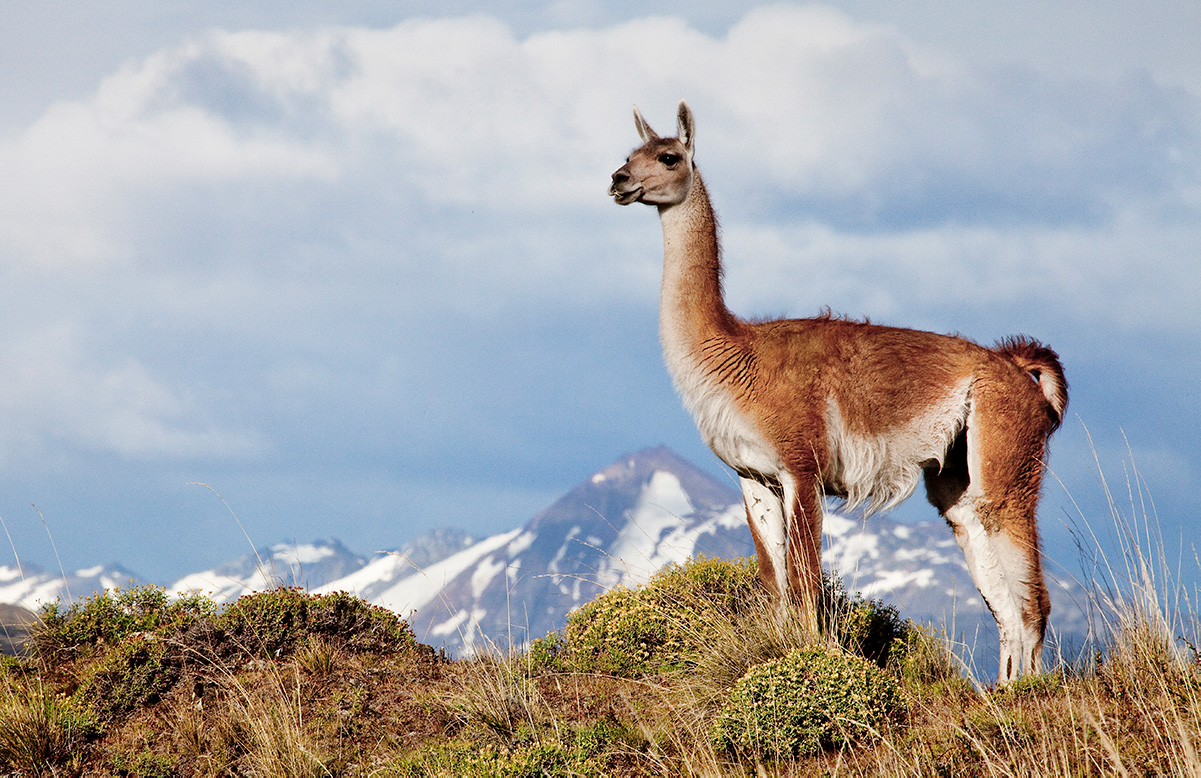 Guanaco in Patagonia National Park. Photo: Linde Waidhofer.
Guanaco in Patagonia National Park. Photo: Linde Waidhofer. By Jimmy Langman and Evelyn Pfeiffer
The big question ever since Chile announced its Route of Parks in Patagonia last year was whether they could go beyond being merely paper parks and effectively protect the ecosystems inside those parks. Now, such concerns are beginning to fade, thanks to a new agreement announced by the Chilean government last week, which together with an international conservation coalition led by Tompkins Conservation and Pew Charitable Trusts is creating a permanent financing mechanism to improve and conserve the national parks of Patagonia.
Called Route of Parks Fund: Protecting Patagonia Forever, it will be a joint public and private fund for a network of 17 national parks spanning more than 1700 miles and 60 Patagonian communities between Puerto Montt in the Lake District to Cape Horn at the southernmost tip of the continent. The agreement seeks to raise money to finance infrastructure, trails, personnel, and equipment to help the Chilean park system match and surpass international standards; foster nature conservation and rewilding projects; and catalyze economic development in the communities surrounding the parks to help them benefit from the significant boost in global tourism the region is likely to witness in the years ahead.
The fund is very welcome in Chile which is currently only investing US$ 5.1 million per year in its national parks in Patagonia. The initiative will be patterned after a conservation finance model called Project Finance for Permanence (PFP), a strategy which in the recent past has successfully led to significant private investment to protect land and marine habitat in Costa Rica, the Amazon rainforest of Brazil, and the British Columbia coastal rainforest in Canada.
 Elephant seals in Alberto de Agostini National Park. Photo: Nicolas Piwonka
Elephant seals in Alberto de Agostini National Park. Photo: Nicolas PiwonkaAt the core of the approach: ensuring long-term financing for a conservation plan that can survive several generations into the future, and releasing the monies raised from private sources to complement public funding from governments only after the overall target amount for financing the entire project is reached.
The Forever Costa Rica program is an example of how this approach works. Prompted by then Costa Rica President Oscar Arias, who in 2007 declared a goal of funding the nation’s protected area system in perpetuity and doubling their marine reserve system, The Nature Conservancy and other private conservation organizations came together to successfully raise US$ 57 million from international sources to fund the plan and in return the Costa Rica government increased its own funding for protected areas, restructured its natural resource management agency, and greatly expanded its marine protected areas. Today, Costa Rica spends US$ 30 per hectare in its national parks, as compared to Chile, which currently spends just US$ 1.54 per hectare in its parks.
Tompkins Conservation says the fundraising goal for the Route of Parks Fund has not yet been determined; in the year ahead, that will become clear as they develop a plan and calculate costs together with other stakeholders in the initiative.
The plan for Patagonia’s national parks will though veer more toward the approach used in British Columbia, Canada. The Nature Conservancy, along with several foundations, set aside half of the $US 100 million they raised for the fund there to finance an economic development fund for 26 indigenous tribes living in or near the coastal rainforests. Similarly, according to Francisco Solis, director of the Pew Charitable Trust’s program in Chile’s Patagonia region, the fund proposed for Patagonia’s parks will place an emphasis on giving “equal attention to community benefits and enhanced nature protections.”
 Pumalin Douglas Tompkins National Park. Photo: Tompkins Conservation
Pumalin Douglas Tompkins National Park. Photo: Tompkins ConservationThe leaders of the Patagonia initiative are understandably overjoyed about the prospects ahead.
“We are very excited to announce the Route of Parks Fund, a new conservation agreement for Patagonia. The future of Chile is green, guys!” Kristine Tompkins, president of Tompkins Conservation and UN Patron of Protected Areas, enthusiastically wrote on her Twitter account shortly after an agreement was reached with Chile.
We are very excited to announce the Route of Parks Fund, a new conservation agreement for Patagonia. The future of Chile is green, guys! @TompkinsConserv @pewenvironment @GobiernodeChile @rutadeparques #patagoniaforever #routeofparksfund pic.twitter.com/UMZ4IX4IVR
— Kristine Tompkins (@KrisTompkins_) May 10, 2019
Chile President Sebastian Pinera called the agreement “a strategic alliance with a very moral significance to protect our parks, to expand our parks, and this is not only out of respect for nature, but also for our children, our grandchildren and future generations"
The 17 national parks included in the agreement are: Alerce Andino, Hornopiren, Pumalín, Corcovado, Melimoyu, Queulat, Isla Magdalena, Cerro Castillo, Patagonia, Laguna San Rafael, Bernardo O´Higgins, Kawésqar, Torres del Paine, Pali Aike, Agostini, Yendegaia and Cabo de Hornos.



